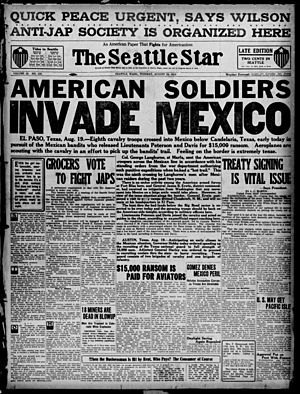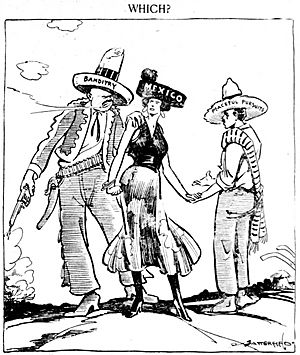Candelaria border incursion of 1919 facts for kids
Quick facts for kids Candelaria border incursion of 1919 |
|||||||
|---|---|---|---|---|---|---|---|
| Part of the Mexican Revolution and the Bandit War | |||||||
 Lt Harold G. Peterson, pilot, and Paul H. Davis, Observer-Gunner |
|||||||
|
|||||||
| Belligerents | |||||||
|
|
||||||
| Commanders and leaders | |||||||
| Jesús Rentería † |
|
||||||
| Casualties and losses | |||||||
| At least 4 killed, including Jesús Rentería | |||||||
The Candelaria border incursion of 1919 was a military operation by the United States. Its goal was to find and stop a Mexican group led by Jesús Rentería. This group had kidnapped two American pilots. The pilots had crashed their plane south of the U.S.-Mexican border. Rentería's group then demanded money for their safe return. The U.S. successfully paid the ransom and got the pilots back.
Contents
Why Did the Incursion Happen?
For nearly ten years, the U.S. and Mexico had many violent events along their border. These were connected to the Mexican Revolution and the Bandit War. Just two months before, in June 1919, U.S. and Mexican forces had a fight near El Paso, Texas. This was called the Battle of Ciudad Juárez.
This battle was special because the Mexican army and the U.S. Army worked together. They fought against a revolutionary group led by Pancho Villa. It was the second-largest battle of the Mexican Revolution that involved the United States. Many people see it as the last major fight of the Border War.
How Did the Incursion Unfold?
On Sunday morning, August 10, 1919, two pilots were on a regular patrol. They were Lt Harold G. Peterson and Paul H. Davis. They were part of the United States Army Border Air Patrol. Their mission was to fly along the Rio Grande in the Big Bend area of Texas. They were supposed to land at Fort Bliss.
The Pilots Get Lost
Near Ojinaga, Chihuahua, they made a mistake. They thought the Rio Conchos river was the Rio Grande. They followed it many miles into Mexico. Then, their engine had problems, forcing them to land. They still thought they were on the American side of the river. The land was rough, and their plane was badly damaged. They buried their machine guns and ammunition. This was to keep them from falling into the wrong hands. Peterson and Davis then started walking. They hoped to reach the U.S. Cavalry outpost at Candelaria, Texas.
The Search Begins
When the pilots did not arrive at Fort Bliss, a search began. Other pilots flew over their patrol route. They realized Peterson and Davis might have flown into Mexico by mistake. The search area was expanded to include the region along the Conchos river. On Tuesday afternoon, Peterson and Davis saw a plane flying. But they were hidden in thick bushes and could not get the crew's attention. The search continued until Sunday, August 17, 1919.
Ransom Demand
On that Sunday, Captain Leonard F. Matlack received news. He commanded Troop K of the 8th Cavalry at Candelaria. He learned that Peterson and Davis were being held for money.
The pilots had been captured on Wednesday, August 13. A man named Jesús Rentería had taken them prisoner. Rentería sent a note asking for money to a rancher in Candelaria. He also forced the pilots to write telegrams. These were sent to their fathers and important U.S. military leaders. Rentería demanded $15,000 (which is about $253,200 today). He said the money had to be paid by Monday, August 18. If not, the two Americans would be killed.
Paying the Ransom
The U.S. War Department agreed to pay the money. But they needed to get $15,000 in cash quickly. Ranchers in the area quickly gathered the full amount from the Marfa National Bank. Through talks with people who helped, a plan was made. Captain Matlack would cross the border on Monday night. He would take half of the money to get one of the pilots back. The meeting happened as planned. Within 45 minutes, Matlack returned with Lieutenant Peterson.
Matlack then took the remaining $7,500 to get Lieutenant Davis. On his way to the meeting spot, he overheard two of Rentería's men talking. They planned to kill him and Davis after they got the rest of the money. At the meeting, Matlack quickly pulled out his gun. He told the Mexicans to tell Rentería to "go to hell." He then rode off with Davis and the money. Matlack and Davis avoided the trap and safely crossed back into the United States.
The Pursuit
On Tuesday, August 19, Captain Matlack crossed the border again at daybreak. This time, he led Troops C and K of the 8th Cavalry. Their mission was to chase Rentería and his men. Air Service planes flew ahead of the cavalry. They looked for the group and gathered information. They dropped messages to the troops about trails and waterholes. The cavalry soldiers found a small building and were shot at from inside. The soldiers attacked the building. They killed four people and captured two. Two others managed to escape.
Later that Tuesday, Lieutenants Estell and Cooper were flying. They saw three men on horseback in a canyon. They flew lower to get a better look. The men on the ground shot at their plane. Estell then made another pass, firing his machine guns. Cooper also fired his Lewis Guns. He killed one of the men, who was believed to be Rentería.
The search for Rentería's group continued until August 23. The Mexican government, led by Venustiano Carranza, protested the U.S. invasion of its land. So, U.S. forces returned to the United States.
What Happened After?
In 1920, the President of the United States honored Captain Leonard F. Matlack. He was given the position and rank of captain on the retired list for his actions.



